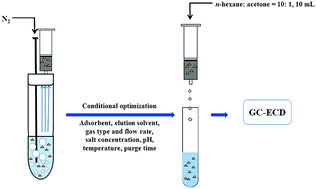Analysis of volatile organic compounds in environmental matrices by nitrogen-assisted headspace solid-phase extraction†
Abstract
A novel pretreatment method named nitrogen-assisted headspace solid-phase extraction (NA/HS-SPE) was developed for the analysis of volatile organic pollutants in water, sediment, honey, and juice. The target compounds including trichloroethylene, tetrachloroethylene, 1,2-dichlorobenzene and 1,2,3,5-tetrachlorobenzene were measured via gas chromatography with an electron capture detector. Factors affecting the extraction efficiency such as the adsorbent, elution solvent, purge gas type, gas flow rate, salinity, pH, temperature and purge time were optimized using ultrapure water via a single factor optimization method. Under optimum conditions, the recoveries were 90.76–100.22%. The limits of detection (LODs) and limits of quantitation (LOQs) were 0.002–0.0371 μg L−1 and 0.008–0.122 μg L−1, respectively. The method can be used to analyze pollutants in rainwater, river water, underground water, sediment, honey, and juice. Recovery tests using real samples at three concentrations showed that the recoveries ranged from 71.29% to 116.06% with relative standard deviations (RSDs) ranging from 0.9% to 15.3%. In addition, the method remained satisfactory when the SPE cartridges were used three times. The NA/HS-SPE method can be easily carried out in the laboratory with no matrix interferences.



 Please wait while we load your content...
Please wait while we load your content...